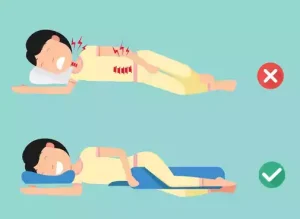20 Sleeping Positions That Can Lead To Death If Not Avoided

Sleep is essential for our well-being, yet the way we position ourselves during sleep could unknowingly pose a risk to our health.…Click Here To Continue Reading>>
Recent studies have shed light on various sleeping positions that may increase the likelihood of health complications, ranging from muscle strain to more severe consequences such as obstructive sleep apnea and even sudden death.
Understanding these potential risks is crucial for maintaining a healthy sleep routine and safeguarding our overall health.
1. Sleeping on Your Stomach:…Read Full Story…>>>
While this position may provide temporary relief for individuals with lower back pain, it can strain the neck and spine, leading to discomfort and potential long-term issues.
2. Sleeping with Arms Above Your Head:
This position can restrict blood flow and lead to nerve compression, causing numbness and tingling sensations in the arms and hands.
3. Fetal Position:
Curling up in a fetal position may feel cozy, but it can restrict breathing and strain the neck and back, particularly if the spine is not properly aligned.
4. Sleeping with Legs Elevated:
Elevating the legs during sleep can improve circulation, but excessive elevation may put pressure on the lower back and lead to discomfort.
5. Sleeping on Your Back with Arms Raised:
This position can cause shoulder pain and restrict blood flow to the arms, leading to numbness and discomfort.
6. Twisted Sleeping:
Twisting the torso or limbs during sleep can strain muscles and joints, potentially leading to stiffness and pain upon waking.
7. Sleeping on a Soft Mattress:
While soft mattresses may feel comfortable initially, they lack adequate support and can cause misalignment of the spine, leading to back and neck pain over time.
8. Sleeping with a Pillow Under Your Stomach:
Placing a pillow under the stomach while sleeping on your front can strain the lower back and pelvic area, exacerbating existing discomfort.
9. Sleeping with a Pillow Between the Knees:
While this position can help align the spine and relieve pressure on the lower back, using a pillow that is too thick may cause misalignment and discomfort.
10. Sleeping with Arms Wrapped Around a Pillow:
This position can restrict blood flow to the arms and cause shoulder pain, particularly if the pillow is too firm or bulky.…Click Here To Continue Reading>>
11. Sleeping with Legs Crossed:
Crossing the legs during sleep can restrict blood flow and cause discomfort in the hips and lower back.
12. Sleeping with Head Resting on Arm:
Resting the head on the arm during sleep can lead to neck pain and stiffness, as well as restricted blood flow to the arms.
13. Sleeping with Chin Resting on Chest:
This position can restrict airflow and lead to breathing difficulties, particularly for individuals with sleep apnea or respiratory issues.
14. Sleeping with Neck Hyperextended:
Hyperextending the neck during sleep can strain the cervical spine and lead to neck pain and stiffness upon waking.
15. Sleeping in a Tight Space:
Sleeping in cramped quarters can restrict movement and lead to muscle stiffness and discomfort upon waking.
16. Sleeping with Wrists Bent:
Bending the wrists during sleep can compress nerves and lead to numbness and tingling sensations in the hands and fingers.
17. Sleeping with Legs Unsupported:
Allowing the legs to hang off the bed or dangle unsupported can strain the lower back and lead to discomfort and stiffness.
18. Sleeping with Head Propped Up on Pillows:
Propping the head up too high can strain the neck and lead to discomfort and stiffness, particularly if the spine is not properly aligned.
19. Sleeping with Hips Twisted:
Twisting the hips during sleep can strain the lower back and pelvic area, leading to discomfort and potential long-term issues.
20. Sleeping with Legs Straight Out:
Sleeping with the legs straight out can strain the lower back and lead to discomfort and stiffness, particularly if the mattress lacks adequate support.
While many of these sleeping positions may seem harmless, repeated exposure to improper sleep posture can contribute to chronic pain and musculoskeletal issues over time. It is essential to be mindful of how we position ourselves during sleep and make adjustments as necessary to promote optimal comfort and health.
Consulting with a healthcare professional or sleep specialist can provide further guidance on achieving a healthy sleep posture and reducing the risk of potential health complications. By prioritizing proper sleep posture, we can safeguard our well-being and enjoy restorative sleep for years to come.



